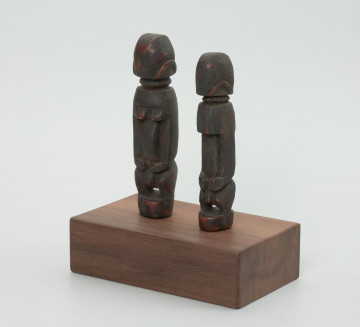
Divination set
między 1951 — 2000
National Museum in Szczecin
Part of the collection: Collection of Dogonian art
The divination set consists of two anthropomorphic figurines representing a pair of first ancestors. The cult of ancestors is strongly developed in the Dogon. They divide them into old and recent dead. The ancient dead, i.e., the first eighty men and women descended from the eight descendants of the first pair of ancestors, are considered the creators of the law and atem - the Dogon tradition. The gniwim or gniwim nam - the recent dead - are instead the guardians of this tradition and law. They watch over order and justice. They protect the weak from the strong, the young from the old, women from men. They administer punishments to those who do not observe the traditions and rules established by the ancient dead. The punishment may be misfortune or illness. The Dogon believe that illnesses are most often the result of breaking the ancestors’ law but can also be caused by supernatural beings or ill-wishing people. The diviner addresses the ancestors by posing questions posed by the client. Patients ask why they are ill and whether they should go to a hospital for treatment or whether it would be more effective to be treated by a witch doctor. After consulting a fortune-teller, they usually go to a witch doctor because treatment at a witch doctor is much cheaper than in hospital. It leads to a division of tasks and interests between a fortune-teller and a witch doctor. The fortune-teller makes the diagnosis and determines the cause of the illness, while the witch doctor prevents the illness by choosing an appropriate remedy. Dio-diougunon, or traditional healers, are reluctant to talk about their remedies because they believe that to be effective, their recipes must remain secret. They treat headaches, toothaches, stomach aches, malaria, diarrhoea and bites, among other things, against which they also make effective protective amulets. They are generally well-known, and the sick can even come to them from very remote villages.
Katarzyna Findlik-Gawron
Author / creator
Dimensions
cały obiekt: height: 15,7 cm, width: 14,7 cm
Object type
sculpture
Creation time / dating
Creation / finding place
Identification number
Location / status

między 1951 — 2000
National Museum in Szczecin

między 1951 — 2000
National Museum in Szczecin

między 1951 — 2000
National Museum in Szczecin
DISCOVER this TOPIC
National Museum in Lublin
DISCOVER this PATH
Educational path